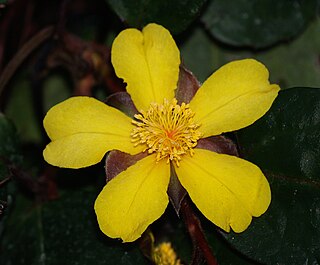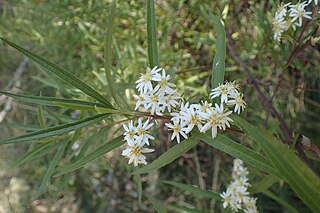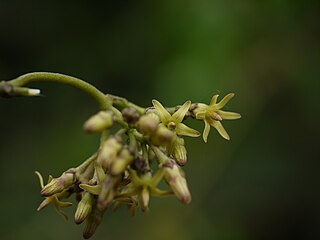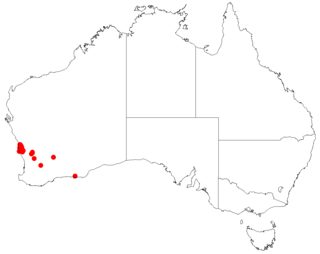
Banksia petiolaris is a rare species of flowering plant in the family Proteaceae native to Western Australia, where it is found in sandy soils in the south coastal regions from Munglinup east to Israelite Bay. It was first described by Victorian state botanist Ferdinand von Mueller in 1864, and no subspecies are recognised. B. petiolaris is one of several closely related species that will all grow as prostrate shrubs, with horizontal stems and thick, leathery upright leaves. Those of this species can be viable for up to 13 years—the longest-lived of any flowering plant recorded. It bears yellow cylindrical flower spikes, known as inflorescences, up to 16 cm high in spring. As the spikes age, they turn grey and develop up to 20 woody seed pods, known as follicles, each.

Banksia blechnifolia is a species of flowering plant in the genus Banksia found in Western Australia. It was first described by Victorian state botanist Ferdinand von Mueller in 1864, and no subspecies are recognised. It gained its specific name as its leaves are reminiscent of a fern (Blechnum). B. blechnifolia is one of several closely related species that grow as prostrate shrubs, with horizontal stems and leathery, upright leaves. The red-brown flower spikes, known as inflorescences, are up to 20 centimetres (8 in) high and appear from September to November in the Australian spring. As the spikes age, each turns grey and develops as many as 25 woody seed pods, known as follicles.

Hibbertia dentata, commonly known as toothed guinea flower, trailing guinea flower or twining guinea flower, is an ornamental plant in the family Dilleniaceae native to the east coast of Australia. Found in woodland, it is a trailing or twining vine with leaves with several small 'teeth' on the margins and bright yellow flowers in early spring. It adapts readily to cultivation and can be grown as a pot plant. The species was first described in 1817.

Parsonsia is a genus of woody vines in the family Apocynaceae. Species occur throughout Indomalaya, Australasia and Melanesia.

Parsonsia straminea, commonly known as common silkpod or monkey rope, is a woody vine of the dogbane family, Apocynaceae. It occurs in the states of New South Wales and Queensland in Australia.

Flindersia maculosa, commonly known as leopardwood or leopard tree, is a species of tree in the family Rutaceae and is endemic to inland areas of eastern Australia. It has mottled bark, simple leaves arranged in opposite pairs, white to cream-coloured flowers and fruit studded with rough points.

Atractocarpus fitzalanii, the brown gardenia or yellow mangosteen, is a species of flowering plant in the family Rubiaceae found in tropical Queensland in Australia. The beautifully scented flowers and lush growth has seen this plant enter cultivation in subtropical gardens in Eastern Australia.

Atractocarpus benthamianus is a species of flowering plant in the family Rubiaceae growing in eastern Australia. It is an understorey species of subtropical and tropical rainforest on fertile soils. The natural range of distribution is from Forster, New South Wales to central Queensland. This plant features beautifully scented flowers.

Acanthocladium dockeri is a critically endangered species of the family Asteraceae that belongs to the monotypic genus Acanthocladium. It is commonly known as spiny everlasting or spiny daisy. It is native to Australia, and is found around the South Australian town of Laura.

Aristolochia praevenosa, synonym Pararistolochia praevenosa, is an Australian plant in the birthwort family, native to Queensland and New South Wales. The Richmond birdwing butterfly vine grows in subtropical rainforest in coastal areas north from Wollongbar, in far north eastern New South Wales and adjacent areas in south eastern Queensland. It has been recorded as far north as the Mary River. It also grows in tropical north eastern Queensland, where it is a food plant for the Cairns birdwing butterfly.

Olearia viscidula, commonly known as the viscid daisy bush or wallaby weed, is a species of flowering plant in the family Asteraceae and is endemic to eastern New South Wales. It is a shrub with scattered narrow elliptic or egg-shaped leaves that are paler on the lower surface, and panicles of white flowers arranged in leaf axils.

Austrocallerya megasperma, one of several species commonly known as native wisteria, is a species of flowering plant in the family Fabaceae and is endemic to eastern Australia. It is a woody climber with pinnate leaves and racemes of purple, pea-like flowers.
Macropteranthes kekwickii, commonly known as bullwaddy, is a species of woody tree or shrub native to the Northern Territory in Australia.

Parsonsia diaphanophleba is a woody vine of the family Apocynaceae. It is found in Western Australia and is listed as a priority 4 species.

Parsonsia alboflavescens is a woody vine of the family Apocynaceae, found from tropical and subtropical Asia to Northern Australia. In the Northern Territory of Australia, where it occurs in Arnhem Land, it has been declared "near threatened".

Palmeria scandens, commonly known as the anchor vine or pomegranate vine, is a climbing plant in the family Monimiaceae prevalent in rainforests of Queensland and New South Wales. It may also be present in New Guinea.

Cyanothamnus subsessilis is a species of plant in the citrus family, Rutaceae and is endemic to the south-west of Western Australia. It is a woody, mostly glabrous shrub with simple leaves and flowers with four petals that are white on the front and green to blue on the back.

Stachystemon polyandrus is a plant in the Picrodendraceae family, found in the south-west of Western Australia.

Leucopogon crassiflorus is a species of flowering plant in the heath family Ericaceae and is endemic to the south-west of Western Australia. It is an erect shrub with few branches and that typically grows to a height of 30–60 cm (12–24 in). Its leaves are broadly egg-shaped with the narrower end towards the base, to more or less round, 2–3 mm (0.079–0.118 in) long with a stem-clasping base. The flowers are borne singly or in pairs in upper leaf axils on a short peduncle, sometimes in small clusters, and with small bracts and bracteoles at the base. The sepals are about 4 mm (0.16 in) long and the petals about 6.5 mm (0.26 in) long, the petal lobes longer than the petal tube.

Leucopogon opponens is a species of flowering plant in the heath family Ericaceae and is endemic to the south-west of Western Australia. It is an erect, slender shrub with its leaves arranged in opposite pairs, and white, tube-shaped flowers.


























